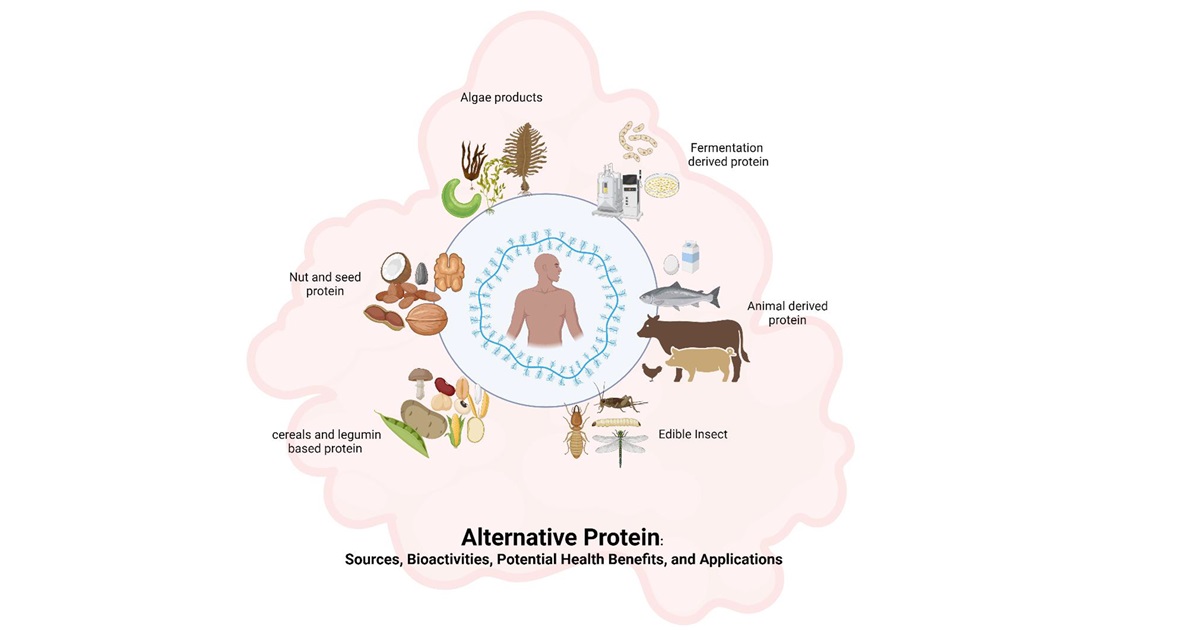Alternative Protein: Sources, Bioactivities, Potential Health Benefits, and Application
A special issue of Foods (ISSN 2304-8158). This special issue belongs to the section "Plant Foods".
Deadline for manuscript submissions: 31 December 2025 | Viewed by 13919

Special Issue Editors
Interests: sustainable protein; bioactive peptide; food chemistry; human health
Special Issue Information
Dear Colleagues,
As the global population continues to rise and increasing concerns over the environmental and health impacts of traditional animal-based protein sources, the search for alternative proteins has gained significant attention. Proteins derived from plants, insects, algae, fungi, and cultured meat technologies offer promising, sustainable solutions for future food systems. Beyond their environmental benefits, many of these alternative proteins exhibit unique bioactive properties that could promote various health advantages.
The special issue "Alternative Protein: Sources, Bioactivities, Potential Health Benefits, and Application" invites submissions of original research, reviews, and perspectives on these innovative proteins. This issue will explore sustainable production methods, including plant-based, insect-derived, algae, fungi, and cell-cultured proteins. We encourage studies that delve into their extraction, and characterisation of bioactive properties—such as antioxidant, antimicrobial, and anti-inflammatory activities—and their potential health impacts, including cardiovascular support, gut health, obesity management, and muscle protein synthesis. Additionally, research on the practical applications of alternative proteins in food products, as well as their sustainability and economic feasibility, is also welcome.
This special issue seeks to be a comprehensive resource for advancing scientific knowledge on alternative proteins, driving innovation in the food industry, and encouraging healthier, more sustainable diets. We invite contributions from food scientists, nutritionists, biochemists, and researchers in related fields.
Dr. Deepak Kadam
Dr. Filiz Koksel
Guest Editors
Manuscript Submission Information
Manuscripts should be submitted online at www.mdpi.com by registering and logging in to this website. Once you are registered, click here to go to the submission form. Manuscripts can be submitted until the deadline. All submissions that pass pre-check are peer-reviewed. Accepted papers will be published continuously in the journal (as soon as accepted) and will be listed together on the special issue website. Research articles, review articles as well as short communications are invited. For planned papers, a title and short abstract (about 250 words) can be sent to the Editorial Office for assessment.
Submitted manuscripts should not have been published previously, nor be under consideration for publication elsewhere (except conference proceedings papers). All manuscripts are thoroughly refereed through a single-blind peer-review process. A guide for authors and other relevant information for submission of manuscripts is available on the Instructions for Authors page. Foods is an international peer-reviewed open access semimonthly journal published by MDPI.
Please visit the Instructions for Authors page before submitting a manuscript. The Article Processing Charge (APC) for publication in this open access journal is 2900 CHF (Swiss Francs). Submitted papers should be well formatted and use good English. Authors may use MDPI's English editing service prior to publication or during author revisions.
Keywords
- alternative proteins
- bioactive peptides
- sustainable protein sources
- health benefits
- food applications
- plant-based proteins
- insect proteins
- algae-derived proteins
- cultivated meat
- functional foods
Benefits of Publishing in a Special Issue
- Ease of navigation: Grouping papers by topic helps scholars navigate broad scope journals more efficiently.
- Greater discoverability: Special Issues support the reach and impact of scientific research. Articles in Special Issues are more discoverable and cited more frequently.
- Expansion of research network: Special Issues facilitate connections among authors, fostering scientific collaborations.
- External promotion: Articles in Special Issues are often promoted through the journal's social media, increasing their visibility.
- Reprint: MDPI Books provides the opportunity to republish successful Special Issues in book format, both online and in print.
Further information on MDPI's Special Issue policies can be found here.






